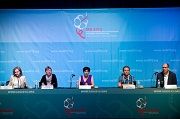Late-Breaking Studies on HIV Prevention, Transmission, and Treatment
A panel of experts discuss information from late-breaking abstracts presented at IAS 2013, including information on the two patients who remain HIV-free following stem cell transplant.

In this press conference from the 7th International AIDS Society Conference on HIV Pathogenesis, Treatment and Prevention (IAS 2013), a panel of experts discuss information from late-breaking abstracts presented at the conference.
Florence Buseyne, PhD, Université Paris Descartes, Faculté de Médecine, EA3620, Paris, France, discussed “Naive CD4 T lymphocytes and recent thymic emigrants, 15 or more years after perinatal HIV infection: the ANRS-EP38-IMMIP study,” which “studied naive (CD4N) and recent thymic emigrant (CD4RTE) CD4 T lymphocytes and their correlates in perinatally infected youths over the age of 15.” The authors concluded that “After at least 15 years of HIV infection, perinatally infected youths had preserved levels of naive CD4 T lymphocytes that positively correlate with both current and past levels of HIV replication. The persistence of an elevated thymic activity that could compensate the deleterious effect of HIV replication is remarkable.”
Una O’Doherty, MD, PhD, University of Pennsylvania, Pathology and Laboratory Medicine, Philadelphia, United States, discussed “Gag-positive reservoir cells are identified by a new technique and are susceptible to HIV-specific cytotoxic T lymphocyte.” In this study, researchers “developed a technique to determine if we could detect resting CD4+ T cells that express HIV Gag protein, in HIV infected individuals on ART.” They also “measured HIV DNA in the Gag+ and Gag- fraction to determine if HIV DNA was enriched in the Gag+ population. We also modeled infection of resting CD4+ cells in vitro by super-infecting CD4+ T cells from patients to determine if the super-infected resting CD4+ T cells would be susceptible to CTL lysis after coculture with autologous CD8s.” They reported that “a measurable fraction of the reservoir in resting CD4+ T cells expresses HIV Gag proteins in patients on ART and may be subject to CTL clearance.”
James Williams, PhD, University of Oxford, Nuffield Department of Medicine, Oxford National Institute of Health Research Biomedical Research Centre, Institute for Emerging Infections, The Oxford Martin School, Oxford, UK, discussed results from “HIV-1 DNA levels after antiretroviral therapy in primary infection predict disease progression: the SPARTAC Trial.” In the study, researchers “investigated whether levels of 'total' and 'integrated' HIV-DNA measured by qPCR after 48 weeks of antiretroviral therapy (ART) were associated with surrogate disease markers and clinical progression in the SPARTAC trial, a large randomized RCT investigating short course ART in Primary HIV Infection.” They reported that “HIV-1 reservoir level after 48-weeks of treatment strongly predicted disease progression, with total HIV-1 DNA levels being more predictive than integrated HIV-1 DNA levels. These data confirm the significance of the HIV-1 reservoir in circulating CD4 cells and its importance in functional cure strategies.”
Timothy Henrich, MD, instructor in medicine at Brigham and Women’s Hospital, discussed “In depth investigation of peripheral and gut HIV-1 reservoirs, HIV-specific cellular immunity, and host microchimerism following allogeneic hematopoetic stem cell transplantation.” In this trial, investigators studied “the longitudinal effects of HSCT on host microchimerism and HIV-specific cellular immunity, and tested rectal tissue and peripheral blood mononuclear cells (PBMCs) obtained by leukapheresis for evidence of residual HIV-1 DNA or replication-competent proviruses up to 4.3 years post-transplantation” in two HIV-positive patients who underwent bone marrow transplants for cancer. They reported that “HIV-1 remained undetectable from peripheral blood and rectal tissue after RIC-alloHSCT in patients on ART despite the testing of very large numbers of PBMCs or CD4+ T cells. The lack of detectable HIV-1 was in the setting of full donor chimerism and weak HIV-specific cellular immunity. Analytical treatment interruption remains the definitive experiment to test the full impact of RIC-alloHSCT on HIV-1 persistence.”
Study abstracts, presentation slides, and additional video are available on the IAS website.
Image by Photo©International AIDS Society/Marcus Rose/Workers' Photos.